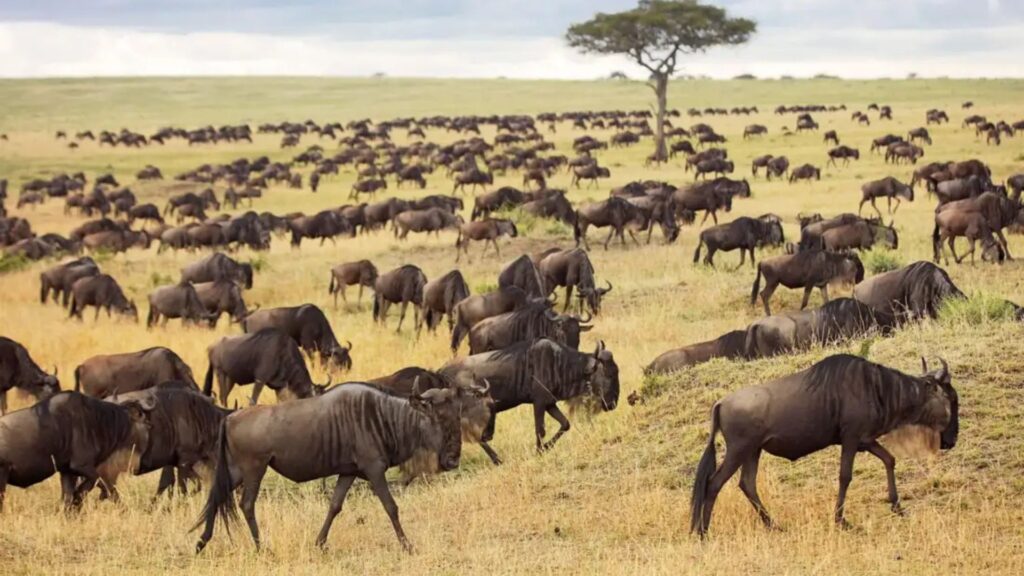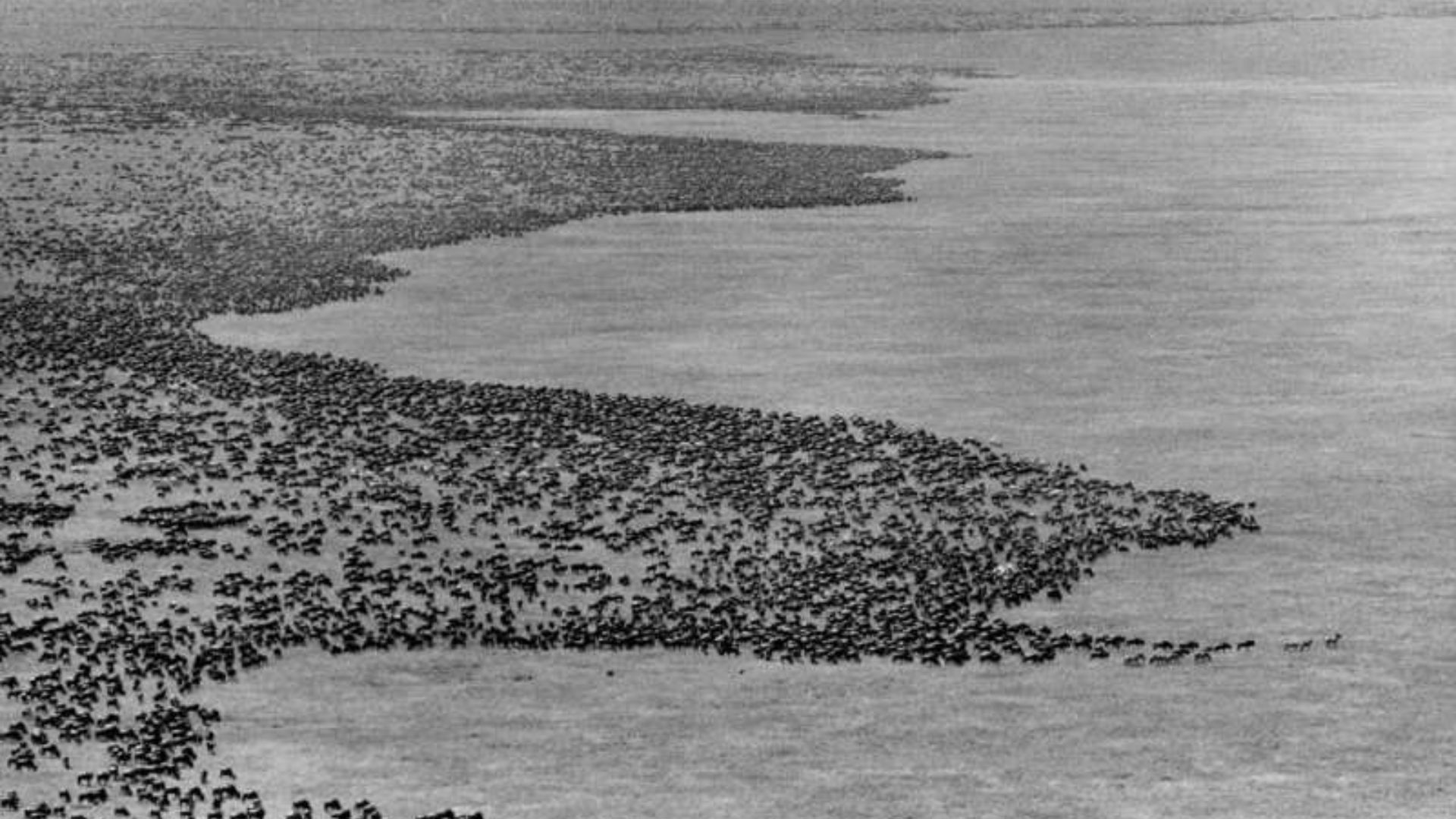
Nicholas Tinelli / Alamy
Breakthrough AI Analysis in PNAS Nexus
A new study published in PNAS Nexus has upended decades of wildlife population data by showing that fewer than 600,000 wildebeest migrate annually across the Serengeti-Mara ecosystem—approximately half of the long-accepted estimate of 1.3 million animals.
Led by Dr. Isla Duporge (Princeton University) and Professor David Macdonald (Oxford University), researchers deployed two deep-learning models—U-Net and YOLOv8—to analyze over 4,000 square kilometers of high-resolution satellite imagery captured by Maxar Technologies’ WorldView satellites in August 2022 and 2023. The AI models achieved accuracy scores up to 0.83, successfully identifying individual wildebeest as small as 6 to 12 pixels in the satellite images.
Traditional Methods Face Modern Scrutiny
For decades, wildebeest counts relied on manned aerial surveys photographing herds along predetermined flight paths. These surveys covered limited areas, requiring statistical extrapolation to estimate densities across unsurveyed regions—an approach prone to errors when herds move between transects or disperse unevenly.
In contrast, the AI-driven approach produced remarkably consistent counts:
- 2022: 324,202 to 337,926 wildebeest
- 2023: 502,917 to 533,137 wildebeest
This means a shortfall of at least 700,000 animals compared to the longstanding 1.3 million figure established in the 1970s.
Conservation Implications and Context
Dr. Duporge cautions that lower counts do not necessarily signal population collapse. Instead, they may reflect changes in migration routes driven by habitat fragmentation, agricultural expansion, infrastructure development, and fencing that disrupt traditional paths. Wildlife corridors have been increasingly severed by new roads and settlements, forcing herds into narrower or alternate routes.
Climate change also plays a critical role. Altered seasonal rainfall patterns shift prime grazing areas, affecting the timing and direction of the Great Migration. Prolonged dry spells or unseasonal rains can deplete forage availability, prompting herds to skirt survey transects used in traditional counts.
Economic and Ecological Stakes
The Great Migration supports Africa’s iconic predators—lions, crocodiles, and spotted hyenas—and generates vital tourism revenue for Kenya and Tanzania. In 2023, wildlife tourism contributed over 12% of GDP in both countries, supporting local communities and conservation initiatives. Accurate population data are crucial for sustainable management, anti-poaching efforts, and habitat protection funding.
Professor Macdonald emphasized the broader implications: “The technological breakthrough of our study revolutionizes monitoring for wildebeest and opens incredible possibilities for tracking other large species, from elephants to rhinos.” Indeed, the Oxford team has released their model code publicly, and efforts are already underway to apply similar methods to detect African rhinos.
AI Models and Methodology
- U-Net: A convolutional neural network architecture optimized for image segmentation, enabling precise identification of animal shapes within complex backgrounds.
- YOLOv8: A real-time object detection framework that balances speed and accuracy, crucial for processing vast satellite datasets.
The two-model approach cross-validates detections, reducing false positives from shadows, vegetation, or other large mammals. By comparing results across both models and multiple image dates, the team achieved robust, reproducible counts.
Study Limitations and Next Steps
While AI surveys offer unprecedented coverage, limitations remain:
- Terrain occlusion: Dense woodlands or riverine vegetation can obscure animals in satellite views.
- Temporal sparsity: Satellite revisit intervals mean some herd movements between image captures go unrecorded.
- Species differentiation: Distinguishing wildebeest from similar-sized herbivores requires further model refinement.
To address these, researchers plan to integrate drone-based imagery and combine optical with synthetic aperture radar (SAR) data, which penetrates vegetation cover. The team also aims to extend the methodology across other African ecosystems, including the Kalahari and Okavango Delta.
Rethinking Conservation Strategies
Conservation organizations must adapt strategies based on these revised population figures. Key recommendations include:
- Prioritizing protection of newly identified migration corridors.
- Increasing anti-poaching patrols in peripheral grazing zones.
- Expanding community-based conservation programs that incentivize local stewardship of wildlife habitats.
Early engagement with Maasai and Turkana pastoralists, whose seasonal grazing lands overlap migration routes, will be critical. Collaborative land-use planning can help balance livestock needs with wildebeest passage, reducing human-wildlife conflicts.
Toward a Data-Driven Future in Wildlife Monitoring
This study underscores a broader shift toward data-driven conservation. As AI and satellite imaging technologies advance, researchers can monitor wildlife populations at scales and frequencies previously unimaginable. Real-time alerts for unusual herd movements or mass die-offs could enable rapid conservation responses to droughts, disease outbreaks, or poaching incursions.
By challenging long-held assumptions about one of Africa’s most emblematic migrations, the AI satellite survey sets a new benchmark for wildlife science. As Professor Macdonald notes, “Our planet’s future depends on the rigor of our data—only then can we craft policies that truly protect biodiversity.”












I don’t think the title of your article matches the content lol. Just kidding, mainly because I had some doubts after reading the article.